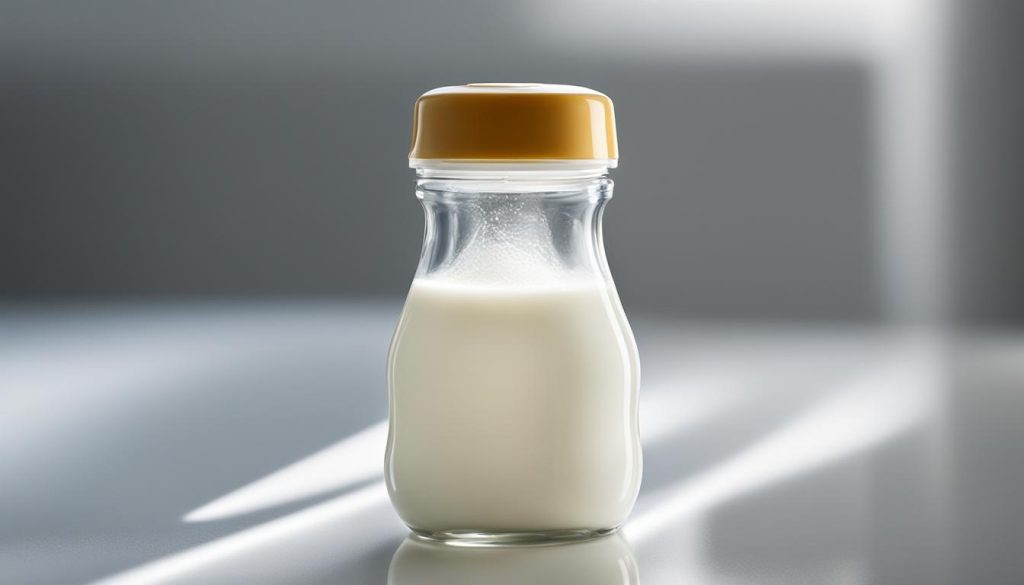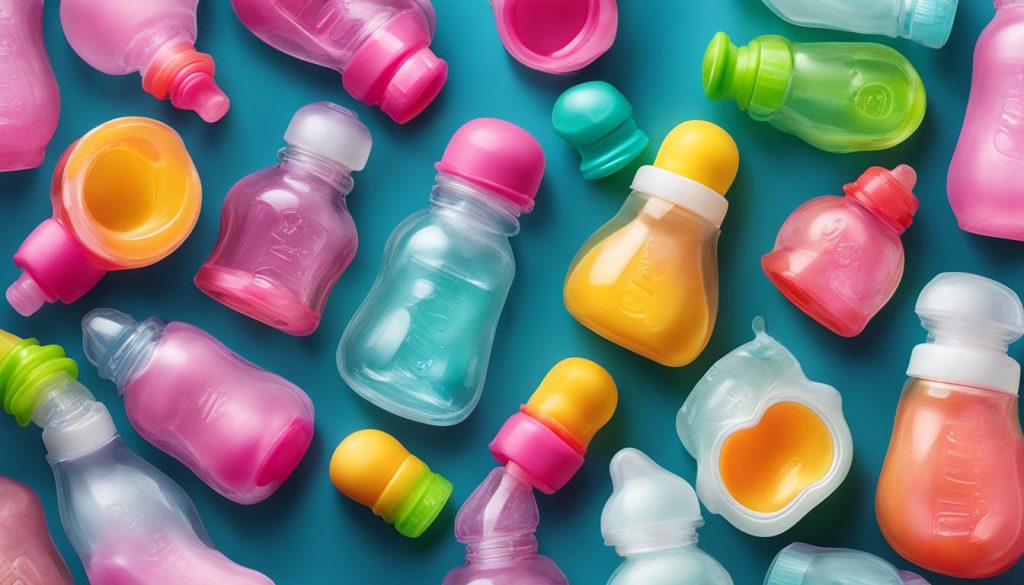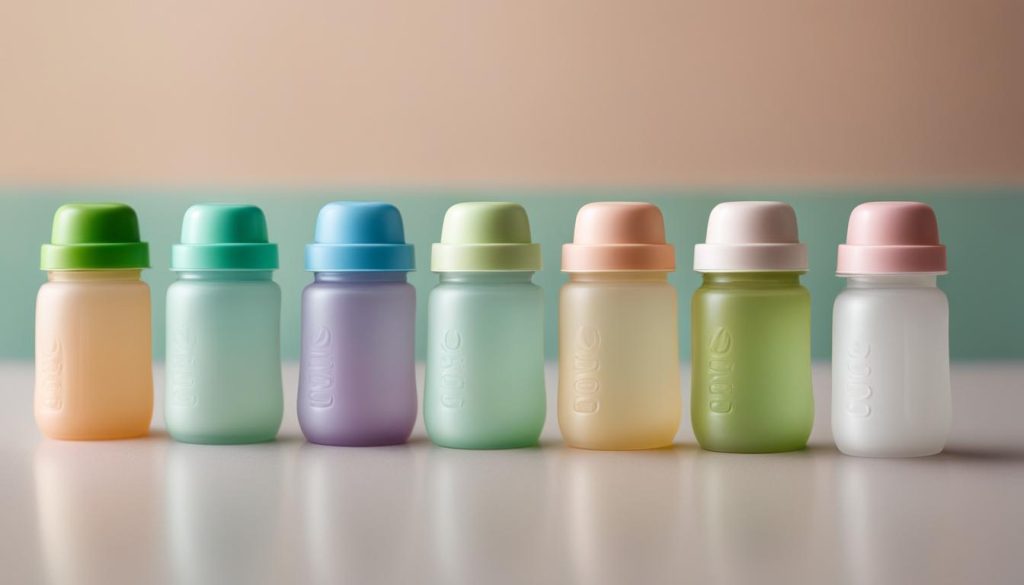If your baby is crying uncontrollably and experiencing discomfort from gas, finding the right bottle can help alleviate these symptoms. In this article, I will explore the best bottles for gas, providing you with top-rated options and reviews.
Importance of a Properly Designed Baby Bottle
When it comes to infant feeding, the design of a baby bottle is of utmost importance. A properly designed bottle can play a significant role in reducing gas and preventing colic, providing a more comfortable feeding experience for your little one.
One crucial aspect to consider is the material used in the construction of the bottle. Different materials, such as glass, plastic, and silicone, can have varying effects on your baby’s feeding. For example, glass bottles are known for their durability and resistance to scratches, while plastic bottles are lightweight and shatterproof. Silicone bottles, on the other hand, offer a soft and flexible feel that mimics the natural texture of a breast.
Another key factor in the design of a baby bottle is the type of nipple used. Nipples come in different shapes and sizes, including traditional, wide-neck, and orthodontic. The right nipple type can promote proper latch and ease gas by minimizing the amount of air your baby ingests during feeding.
The Importance of Infant Feeding
The design of a baby bottle directly influences the feeding experience for both baby and parent. By choosing a bottle that is designed with your baby’s comfort and gas reduction in mind, you can ensure a peaceful and enjoyable feeding time. It is essential to compare the materials used in baby bottles and consider the different nipple types available to find the best fit for your little one.
“A properly designed baby bottle can make a world of difference in reducing gas and improving the feeding experience for both baby and parent.”
| Material | Advantages | Disadvantages |
|---|---|---|
| Glass | Durable, scratch-resistant | Heavier, breakable |
| Plastic | Lightweight, shatterproof | Potential for chemical leaching |
| Silicone | Soft, flexible feel | May require more frequent replacement |
Choosing the right bottle design can greatly impact your baby’s comfort and overall feeding experience. By comparing materials and nipple types, you can make an informed decision that promotes better digestion and lessens the likelihood of colic or gas-related discomfort.
Factors to Consider When Choosing a Bottle for Gas
When it comes to selecting a bottle for gas, there are several important factors to keep in mind. By considering these factors, you can ensure that you choose a reliable gas bottle that will provide the best possible feeding experience for your baby.
Anti-colic Vent System
An anti-colic vent system is a crucial feature to look for in a bottle for gas. This system helps to reduce the amount of air your baby ingests while feeding, minimizing the risk of gas and discomfort. It works by venting air out of the bottle, preventing it from entering your baby’s digestive system.
An efficient anti-colic vent system can significantly alleviate gas-related issues and help keep your baby comfortable during feeding times. Look for bottles that have well-designed vents and check customer reviews to ensure their effectiveness in reducing gas.
Durability and Reliability
When choosing a bottle for gas, durability and reliability are essential factors to consider, especially if you plan to use the bottle for gas storage. Look for bottles made from high-quality materials that are durable and resistant to breakage.
Additionally, consider the bottle’s overall design and construction. Look for bottles that are leak-proof and easy to assemble and disassemble for cleaning. A reliable bottle will not only provide a gas-free feeding experience but also ensure that the bottle lasts through multiple uses.
Buying Guide Assistance
If you’re unsure about which bottle to choose, a gas bottle buying guide can provide valuable assistance. These guides typically offer detailed information about various bottles on the market, including their features, pros, and cons. They can help you compare different options and make an informed decision based on your specific needs and preferences.
By considering the anti-colic vent system, durability and reliability, and consulting a buying guide, you can choose the best bottle for gas that suits both you and your baby’s needs. Taking the time to research and evaluate different options will ensure a comfortable and gas-free feeding experience.
Top Picks of Bottles for Gas
When it comes to finding the best bottle for gas, there are several options on the market that offer high quality, affordable, and durable solutions. These bottles are designed to reduce gas and colic symptoms, providing a comfortable feeding experience for your baby. Here are our top picks:
1. Philips Avent Anti-Colic Bottle with AirFree Vent
This bottle features an innovative AirFree vent system that helps reduce air intake, preventing gas and colic. It has a wide nipple shape that promotes a natural latch and easy transition between breastfeeding and bottle feeding. The bottle is made from BPA-free materials, ensuring the safety of your baby.
2. Dr. Brown’s Natural Flow Anti-Colic Options+ Narrow Baby Bottle
Dr. Brown’s bottles are known for their anti-colic features, and the Options+ Narrow Baby Bottle is no exception. It has a unique venting system that minimizes air intake and prevents nipple collapse. The bottle is made from high-quality materials and is designed to be easy to clean.
3. MAM Easy Start Anti-Colic Bottle
The MAM Easy Start bottle is specifically designed to reduce gas and colic symptoms. It features a vented base that regulates the pressure inside the bottle, preventing the formation of air bubbles. The bottle has a wide opening for easy filling and cleaning, and the nipple is made from soft silicone for a comfortable feeding experience.
4. Comotomo Silicone Bottle
The Comotomo Silicone Bottle is designed to mimic breastfeeding, making it an excellent choice for babies with gas or colic. It has a wide and flexible body that allows for natural feeding motions and easy cleaning. The bottle is made from 100% safe materials and is free from BPA, PVC, and phthalates.
These top picks provide reliable solutions for gas and colic, ensuring a peaceful feeding experience for both baby and parents. Consider your baby’s needs and preferences when choosing the right bottle, and consult with experts for additional guidance. With the right bottle, you can help alleviate gas and provide your baby with a comfortable feeding experience.
Importance of Bottle Maintenance and Sterilization
When it comes to ensuring a hygienic feeding experience for your baby, proper bottle maintenance and sterilization are of utmost importance. As a new parent, it is essential to follow specific guidelines and tips to minimize the risk of contamination and keep your baby safe and healthy.
Here are some expert-recommended tips on bottle maintenance and sterilization:
- Clean bottles after every use: Wash bottles, nipples, and other feeding accessories with warm, soapy water. Use a bottle brush to thoroughly clean the inside and outside of the bottles, paying close attention to hard-to-reach areas.
- Sterilize bottles regularly: Sterilize bottles at least once a day, especially for newborns. You can use boiling water, steam sterilizers, or microwave sterilization bags. Follow the manufacturer’s instructions for the specific sterilization method you choose.
- Avoid using harsh chemicals: Steer clear of harsh cleaning agents, bleach, or abrasive scrubbers that can damage the bottles or leave residues. Opt for baby-safe dish soap and sterilization solutions recommended for feeding equipment.
- Thoroughly dry bottles: After cleaning and sterilization, let the bottles air dry completely to prevent the growth of bacteria. Consider using a clean, lint-free towel or a bottle drying rack to ensure proper drying.
By maintaining a clean and sterilized bottle, you can provide your baby with a safe and healthy feeding experience. Consult with your pediatrician for specific recommendations on bottle maintenance and sterilization that suit your baby’s needs.
| Common Bottle Maintenance Mistakes to Avoid | |
|---|---|
| Mistake | Solution |
| Not cleaning the bottles thoroughly | Use a bottle brush and hot, soapy water to clean all parts of the bottle, including the nipple and cap. |
| Mixing different brand bottles and accessories | Stick to one brand of bottles and accessories to ensure a proper fit and compatibility. |
| Skipping regular sterilization | Make sterilization a part of your daily routine, especially for newborns. |
| Storing bottles without proper drying | Allow bottles to air dry completely before storing to prevent mold and bacterial growth. |
Expert Advice for Choosing the Right Bottle for Gas
When it comes to choosing the right bottle for gas, expert advice is invaluable. As a professional copywriting journalist, I have gathered insights from pediatricians and experienced parents to help you make an informed decision. Here are some tips to consider:
1. Reduce Air Intake:
An essential feature of a gas-reducing bottle is its ability to minimize air intake during feeding. Look for bottles with anti-colic vent systems that help prevent the ingestion of excess air. These vents regulate the flow of milk and reduce the formation of air bubbles, ultimately alleviating gas and discomfort for your baby.
2. Find a Comfortable Latch:
A proper latch is crucial for a comfortable feeding experience. Opt for bottles that mimic the natural shape and feel of a breast, as they promote a seamless transition between breastfeeding and bottle feeding. Nipple designs that offer a wide base and soft texture can enhance your baby’s latch and reduce the risk of gas-related issues.
3. Consider Easy Cleaning:
Keeping your baby’s bottle clean is essential for maintaining hygiene and preventing the growth of harmful bacteria. Choose bottles that are easy to disassemble and clean thoroughly. Look for designs that have few parts and are dishwasher-safe for added convenience. Remember to sterilize the bottles regularly to ensure a safe feeding environment.
By following these expert tips and considering your baby’s specific needs, you can choose a bottle that minimizes gas and provides a comfortable feeding experience. Consulting with pediatricians and experienced parents can further assist you in finding the perfect bottle for your little one.
When to Transition from Anti-Colic Bottles
Transitioning from anti-colic bottles to regular bottles is an important milestone for your baby’s feeding journey. Although anti-colic bottles have been designed to reduce gas and colic symptoms, there comes a point when your baby may no longer require their specialized features. The timing of this transition depends on various factors, including your baby’s age, feeding habits, and comfort level.
Experts recommend observing your baby’s feeding patterns and cues to determine when it may be appropriate to stop using anti-colic bottles. As your baby grows older and develops better control over feeding, their digestive system may become more efficient in handling gas on its own. Additionally, if your baby appears comfortable during feedings, shows no signs of significant gas or colic discomfort, and is successfully burping after meals, it could be an indication that they are ready for a transition.
It is important to note that every baby is unique, and there is no specific age or timeframe that suits all. Some babies may need anti-colic bottles for a longer duration, while others may transition earlier. As a parent, it is crucial to trust your instincts and consult with your pediatrician for guidance tailored to your baby’s individual needs.
Tips for Transitioning from Anti-Colic Bottles:
- Start by introducing regular bottles during daytime feedings, when your baby is typically more alert and responsive.
- Observe your baby’s reaction and comfort level with the new bottle. If they seem content and show no signs of increased gas or discomfort, gradually transition to regular bottles for all feedings.
- Consider using bottles with a slow flow nipple to mimic the pace of breastfeeding, as this can help prevent excessive air intake and reduce the risk of gas.
- Continue to monitor your baby’s feeding habits and overall well-being during and after the transition. If any concerns arise, consult your pediatrician for further guidance.
Remember, the transition from anti-colic bottles is a gradual process that requires patience and understanding. By closely observing your baby’s needs and seeking professional advice, you can confidently navigate this milestone and provide them with the most comfortable and enjoyable feeding experience.
| Pros of Transitioning from Anti-Colic Bottles | Cons of Transitioning from Anti-Colic Bottles |
|---|---|
| Increased independence in feeding for your baby | Potential increase in gas or colic symptoms |
| Cost savings as regular bottles are generally less expensive | Adjustment period for both baby and parent |
| Easier bottle cleaning and maintenance | Possible need for trial and error to find the right regular bottle for your baby |
Conclusion: A Peaceful Feeding Experience
After exploring the best bottles for gas and considering the importance of proper design, factors to consider, top picks, bottle maintenance, expert advice, and transitioning from anti-colic bottles, it’s clear that finding the right bottle for gas can greatly contribute to a peaceful feeding experience.
By following the guidelines provided, you can ensure peaceful feeding times for both you and your baby. The bottles mentioned in this article, such as the Philips Avent Anti-Colic Bottle, Dr. Brown’s Natural Flow Anti-Colic Options+, MAM Easy Start Anti-Colic Bottle, and Comotomo Silicone Bottle, offer reliable and durable solutions to address your baby’s gas troubles. These high-quality bottles provide anti-colic vent systems, reducing air intake and minimizing discomfort.
Remember to prioritize bottle maintenance and sterilization to maintain a hygienic feeding experience. Cleaning and sterilizing baby bottles regularly will help prevent contamination and ensure your baby’s health and well-being.
Ultimately, finding the right bottle for gas is crucial for creating a peaceful feeding experience. By considering factors such as design, materials, expert advice, and your baby’s specific needs, you can make an informed choice. Say goodbye to gas troubles and embrace a calm and comfortable feeding journey with your little one!
FAQ
What factors should I consider when choosing a bottle for gas?
Factors to consider include the presence of an anti-colic vent system, bottle durability, reliability, and suitability for gas storage.
What are the top picks for bottles that help alleviate gas and reduce colic?
Our top picks include the Philips Avent Anti-Colic Bottle with AirFree Vent, Dr. Brown’s Natural Flow Anti-Colic Options+ Narrow Baby Bottle, MAM Easy Start Anti-Colic Bottle, and Comotomo Silicone Bottle.
How should I maintain and sterilize baby bottles for a hygienic feeding experience?
Follow specific guidelines and tips for cleaning, sterilizing, and storing bottles to minimize the risk of contamination.
What advice do experts give for choosing the right bottle for gas?
Experts recommend considering your baby’s specific needs and preferences, finding a bottle that reduces air intake, provides a comfortable latch, and seeking advice from pediatricians and experienced parents.
When should I transition from anti-colic bottles to regular bottles?
Consider your baby’s age, feeding habits, and comfort level to determine when to transition from anti-colic bottles to regular bottles.




